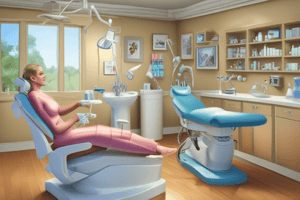Podcast
Questions and Answers
What is the first step in preparing occlusal rest seats in sound enamel?
What is the first step in preparing occlusal rest seats in sound enamel?
- Using a larger round bur to lower the marginal ridge (correct)
- Widening the rest seat preparation
- Applying fluoride gel to the tooth
- Using a polishing point to smooth the surface
What should be the inclination of the floor of the occlusal rest seat?
What should be the inclination of the floor of the occlusal rest seat?
- Vertical from the marginal ridge
- Slightly inclined apically from the marginal ridge (correct)
- Horizontal from the marginal ridge
- Slightly inclined coronally from the marginal ridge
In existing restorations, if the occlusal rest seat is too shallow, what is a recommended solution?
In existing restorations, if the occlusal rest seat is too shallow, what is a recommended solution?
- Compensate by widening the rest seat
- Place a new restoration instead
- Make the rest seat horizontal
- Use a secondary occlusal rest on the opposite side (correct)
Which technique is used to shape the floor of an occlusal rest seat?
Which technique is used to shape the floor of an occlusal rest seat?
What must be ensured when preparing occlusal rest seats in new restorations, crowns, and inlays?
What must be ensured when preparing occlusal rest seats in new restorations, crowns, and inlays?
Flashcards
Occlusal rest seat preparation
Occlusal rest seat preparation
The process of shaping enamel on the occlusal surface of a tooth to create a smooth, spoon-shaped indentation for the rest of a dental prosthesis.
Rest seat preparation on sound enamel
Rest seat preparation on sound enamel
The preparation of rest seats should be done on sound enamel, ensuring no undercuts remain.
Rest seat inclination
Rest seat inclination
The floor of the occlusal rest seat should be slightly inclined apically (towards the root) from the marginal ridge.
Widening rest seats in existing restorations
Widening rest seats in existing restorations
Signup and view all the flashcards
Rest seat clearance in new restorations
Rest seat clearance in new restorations
Signup and view all the flashcards
Study Notes
Rest Seat Preparations
- Rest seat preparations should be made in sound enamel, following proximal guiding planes to eliminate undercuts.
- Occlusal rest seats in sound enamel are prepared using burs and polishing points, aimed to achieve a smooth surface similar to the original enamel. A larger round bur is used initially to lower the marginal ridge and establish the rest seat outline.
- A smaller round bur then deepens the occlusal rest seat floor, creating a spoon shape. Polishing points finalize the preparation contour.
- Fluoride gel should be applied to abutment teeth after enamel re-contouring.
- Occlusal rest seats in existing preparations can be widened to compensate for shallowness, but the floor should still be apically inclined from the marginal ridge. A secondary occlusal rest can be used if this isn't possible, placed on the opposite side of the tooth to prevent slipping.
- Occlusal rest seats in new restorations, crowns or inlays, should provide clearance in the preparation.
- Sufficient occlusal reduction is important to accommodate the rest seat depth in the abutment crown.
Studying That Suits You
Use AI to generate personalized quizzes and flashcards to suit your learning preferences.




